Today we’re investigating Beatport and trying to understand what happened in the Beatport Top 100 chart during 2020.

Inspired by this post from EDMPROD, I’ve decided to analyze Beatport’s Top 100 in 2019 and 2020 to understand a couple of things that intrigued me in 2020. In addition, I looked up the play count on Spotify from the Top 100 tracks on Beatport as well to contrast some data I was curious about as well. Here are some questions I had at the beginning of this study:
- Did the coronavirus play a role in any genre when comparing 2020 with 2019?
- Did any genre gain more traction in 2020? Did any genre lose traction in 2020?
- What key are the tracks inside the top 100 in?
- How long are the tracks from each genre? Did it change from 2019 to 2020?
- What song structure was the most common among the songs there? Is there any difference depending on the genre?
- Will you have lots of plays on Spotify if you get on Beatport’s Top 100?
After some analysis, let’s dive right into what I’ve found! Here are the topics we’ll cover today:
- What Can You Take From This Analysis?
- How Long Will Your Song Stay in the Top 100?
- The Genre Dance in 2020
- 2020 Top 100
- Beatport Top 100 Song Structure
- Song Key
- Is a Top 100 Spot on Beatport a Guarantee for Spotify Plays?
Disclaimer: For this post to be possible, I partnered up with BPTopTracker, a website that tracks Beatport’s Top 100s for all genres and that you can track your own performance as well on Beatport, who provided all the data we are looking at today.
What Can You Take From This Analysis?
Since it’s a fact that some genres have more exposure than others therefore, you’re more likely to gain exposure based on the genre that you’re working on. The first thing you have to understand is how well-positioned your genre is on Beatport.
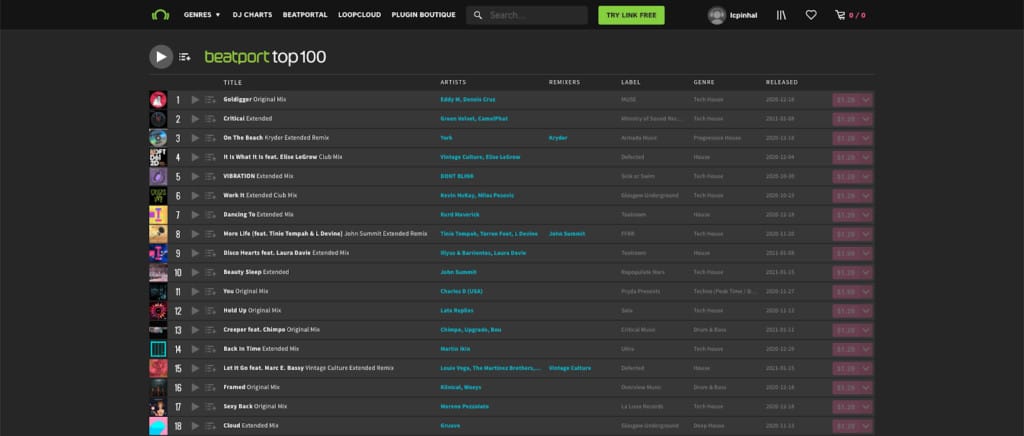
In addition to that, you can go deeper and understand more elements about the top 100. For example, understand the length of the tracks in your genre, the top structures, and the fact that “Beatport Success” doesn’t mean “Spotify success”.
Lastly, understand how favorable your genre is to your goals. If you aim to achieve 1.000.000 plays with a track, but the top tracks of your genre don’t have this amount normally, how and why will you be the one who will pull it off?
If anything, the simple fact of taking an objective look at data from Beatport and from Spotify could help you tremendously. If you want to make a career out of your music, you will have to make something that pays your bills, and this objective and analytical look into data could be a really useful way to detect trends and possible opportunities for your craft to shine even more.
How Long Will Your Song Stay in the Top 100?
According to the data from 2020, most likely that your song won’t stay longer than 15 days. 54% of the songs that made it to the top 100 within 2020 didn’t stay longer than 15 days in this list, and 41% didn’t stay longer than 10 days.
Hitting the top 100 on Beatport is still hard and, even though 1651 songs made it in 2020, only 413 (25,0%) stayed there for longer than 1 month. Here’s the distribution in 10-day buckets (from 1 to 10 days, etc):

The longest song in there was Return to OZ (Artbat Remix) by Monolink, which was there from May 18th, 2019 until June 7th, 2020 nonstop and then had a couple extra in and out days, totaling 395 days. Even though it left the main Top 100, the song is still rocking high in the Melodic House & Techno Top 100s though:
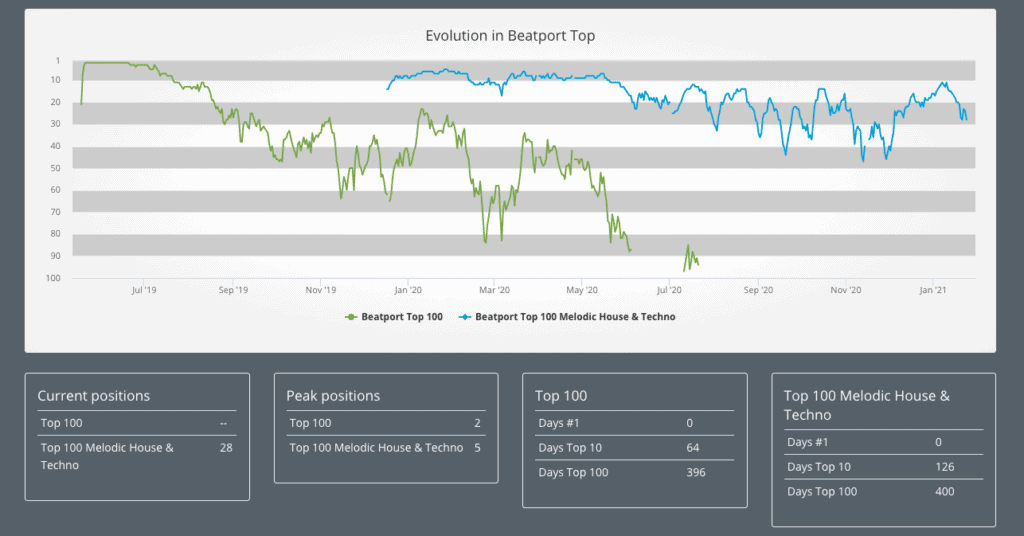
The main takeaway here is that if you ever get in the Top 100 and you pass 60 days in there, consider yourself a winner because you’re in the top 10% of the songs that ever make it into the list.
The Genre Dance in 2020
To understand the most frequent genres within the top 100, we’ve established a simple methodology: Amount of songs per day from each genre summed by month. In other words, if Fisher’s Losing It stayed for 30 days inside the Top 100, it counts as 30 points inside the chart below for Tech House in that month. This is what we’ve got:
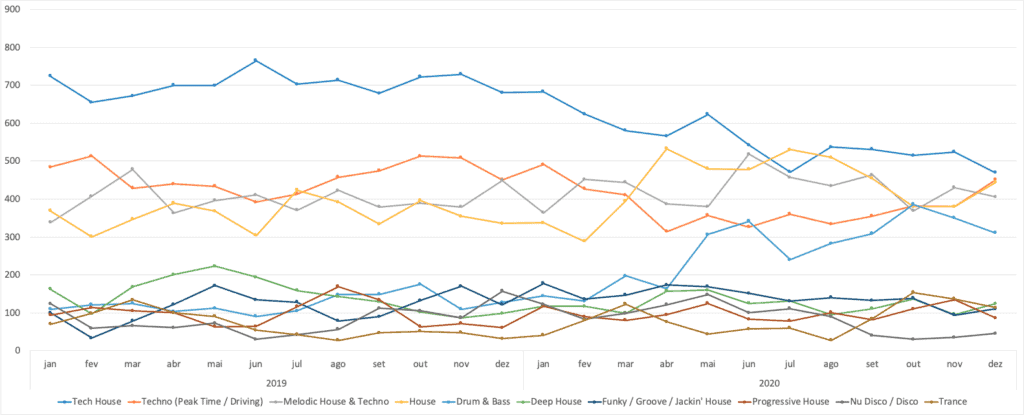
Some other genres without a high amount of points were hidden from the chart and here are some takeaways you see in the chart above:
- Tech house presence is heavily declining since 2020, but still pretty relevant;
- House music got a huge boost since February and stayed consistent, even passing Tech House and taking the lead in July/2020;
- Since May/20, Melodic House & Techno got a boost, taking the second or third spot in the Beatport charts through 2020;
- Peak Time Techno suffered in March/20, probably due to lockdown and clubs closing, but regained its position after clubs started reopening. In my opinion, one of the only impacts from the Coronavirus crisis we’re going through;
- While Deep House lost fifth place from 2019 to 2020, Drum ‘n’ Bass got a huge boost since May and stayed consistent in the Top 5 genres within Beatport;
- Trance (not in the chart above) got a small boost in Oct, Nov and Dec/20, although still not enough to become the 5th genre and performing really badly in 2020 overall.
2020 Top 100
The top 100 from Beatport in 2020 was composed of 13 genres, although 77% of the tracks belong to 4 genres only. Look at the composition of the Top 100 by genre below:
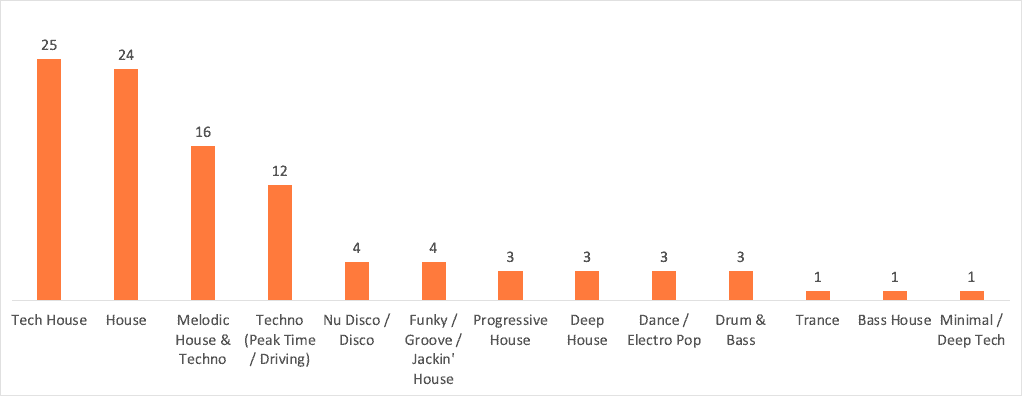
Or, in a pie chart:
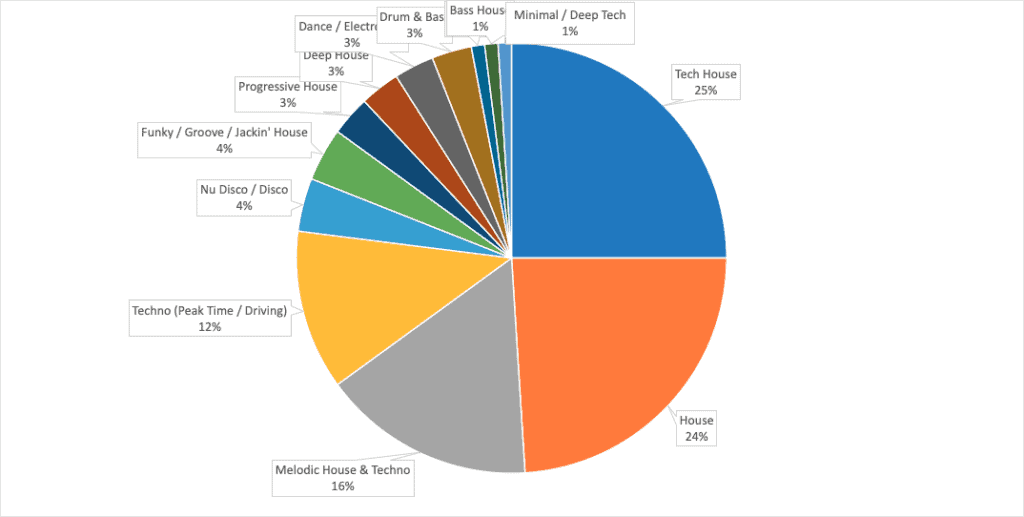
Turns out that if you were in the top 100 from Beatport in 2020, your track has a 49% chance of being Tech House or House Music and a 28% chance of being Melodic House & Techno or Techno (Peak Time). Basically, these genres dominate Beatport.
If we’re considering the songs that reach Beatport’s Top 10, that’s even more concentrated. 85% of the songs that reached the Top 10 in 2020 were among one of these four genres mentioned: Tech House, House, Melodic Techno & House, Techno (Peak Time).
Lastly, from these 100 tracks, 11 tunes were marked as “Mainstream”, which happened because of their presence on playlists with the most followers on Spotify. In the Top 100, they are spread all over the chart, from the top 10 to the bottom 10 and don’t follow any real trend.
What can we conclude from this?
- These are the genres that are getting the most attention from people buying tracks on Beatport and, most likely, reflect the genres that are mostly being played at gigs. Therefore, if you’re producing one of these genres, not only do you have a higher chance of being played, but you also have a bigger chance of being on the top charts.
- Mainstream tracks only accounted for 11 of the top 100. Although they have a small percentage, when we move to Spotify, the “game” changes A LOT.
Beatport Top 100 Song Structure
I analyzed all 100 songs to understand if they follow a structured pattern, and some interesting things were noticed. To make things easier, I’ve labeled ‘Drops’ as “D” and ‘long breaks’, or longer than 8 bars ‘build-ups’ and ‘bridges’ as “B”. This is what I’ve found:

The vast majority of the songs are composed of two breaks/big build-ups and three drops (DBDBD), followed by songs that are structured with two long drops and one break in-between (DBD). Some curious facts about these though:
- 70% of the Tech-house tunes followed a DBDBD structure;
- 70% of the Techno tracks followed a DBD structure;
- 44% of the Melodic Techno tracks followed a DBDBD structure;
- 50% of the Mainstream songs had a BDBD or BDBDBD structure, which starts with a Break that leads to a Drop, instead of the opposite.
However, the length of these drops varies according to the genre. If you look at the chart below, you’ll see that some genres are way longer than others:

We can see that the song lengths vary a lot from genre to genre. Therefore, how long each section (B or D) will be according to the length of the genre. What is curious to see though is that:
- Progressive House doesn’t have many breaks during the song, normally following a DBD structure, even though they are the longest among these tunes. This means that it has longer drops than other genres;
- Melodic House & Techno tracks, even though really similar in length to Progressive House, have a majority of songs in a DBDBD structure, with DBD as second and DBDBDBD as third. This means that drops are smaller and the song changes sections more often than Prog-House;
- Techno is predominantly DBD and the third-longest genre, which means their drops are really long compared to other genres. Check the waveform of ‘SGADI LI MI’ by Charlotte De Witte, one of the top techno tracks, for example:

- Mainstream songs are on average 14% shorter (50s) than non-mainstream songs, but that’s not the case for all the mainstream songs. Their average is 5m32s long, which considering 1-2m of “extended” sections, leaves 3m30s for the “radio versions”.
Knowing the length and structure of your genre is really important since it will determine how your track will flow. It’s important to mention that there isn’t a “formula” for the genres, but surely we can notice some trends that your arrangements might benefit from if you follow them.
If you want to understand more about song arrangement and how to reference it, check this post and this post that we’ve made.
Song Key
Now, when we try to understand what is the key of these songs, we have some good and bad news. Although there’s a 30% likelihood of the track being in Amin and A#min, there’s no clear concentration of tracks in one single key inside the 2020’s Top 100. Here’s the distribution:

Amin and A#min, as mentioned, are the preferred keys, representing 30% of the songs in the top 100 from 2020. However, you can see that every key has appeared in this Top 100, which is awesome because it shows that there isn’t a key restriction.
The story changes a bit when we compare the difference between major and minor keys:
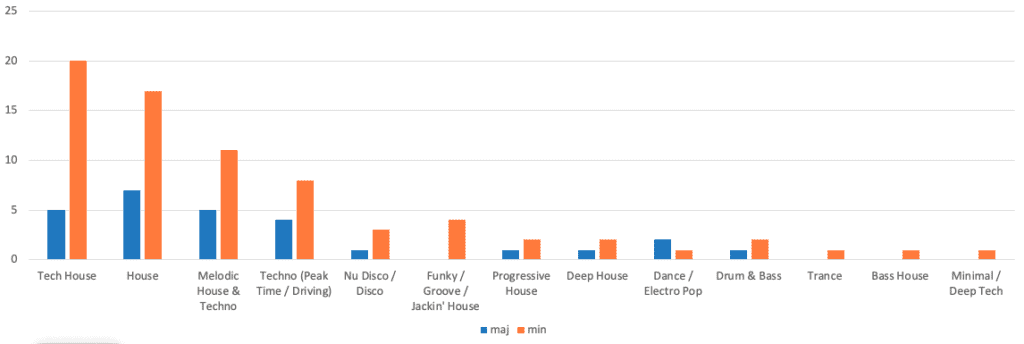
A whopping 73% of the tracks are in a minor key.
House music has a good variety of tracks in the major keys well; Tech House, however, is mainly a minor genre, with 80% of its tracks in Minor keys. If we go deeper, 55% of the Tech House songs in minor keys are either in Amin or A#min, which can show some concentration and limitations as “where you need to go to” if you want the Top 100.
And with this info, we can say the following:
- Even though Minor Keys are preferred, you have the freedom to explore whatever key you prefer;
- If you’re in Tech-House, seriously consider doing your track on a minor key. Or, if you want to be different and try to innovate, consider a major key.
Disclaimer: This study didn’t consider tracks in different greek modes, like Dorian. I simply used Beatport’s key definition.
Is a Top 100 Spot on Beatport a Guarantee for Spotify Plays?
The simple answer is NO. In fact, it doesn’t really relate to it at all.
Beatport counts how many digital downloads your track is getting through that platform, which nowadays is really limited to mainly DJs and people who still don’t use any kind of streaming platform. However, streaming accounts for the largest part of the music industry nowadays, so Beatport is not a place for fans anymore.
Streaming, on the other hand, is used by 80% of the people who consume music, so Spotify, Apple Music and other streaming platforms are where your “average listeners” will be.
Therefore, Beatport DOES NOT relate so well to a good Spotify play count since it’s frequented by different audiences. If you don’t believe this still, let the numbers convert you.
On Jan 14th, 2021, I counted how many plays all the 100 songs had on Spotify and here are the results:
- From the tracks in the Top 100 of 2020, 76,5% of the plays on Spotify came from 11 mainstream songs. In other words, from 1.023.661.728 plays the Top 100 accounts for on Spotify, 783.817.623 plays come from mainstream tracks;
- Head & Heart by Joel Corry and The Business by Tiesto, the two most played songs in the Top 100 list, account for 52,5% of all the plays in the Top 100 (538 Million plays);
- While Mainstream songs have an average of 24.505.262 plays per song (excluding Head & Heart by Joel Corry and The Business by Tiesto), non-mainstream songs have an average of 2.725.501 plays.
- There are 13 songs in there with less than 200.000 plays on Spotify, 33 with 200k-1M, 42 with 1M-10M plays, and 12 with over 10 Million plays on Spotify.

- The higher you go in the top 100, the bigger is the likelihood of your track having more Spotify plays. However, there is one track within the Top 20 with less than 200k plays, so being that high on the list doesn’t mean you’ll have huge numbers. Joel Corry’s track was in #99 of that list, for example.
- Drum ‘n’ Bass, Funky / Jackin House, and Minimal /Deep Tech are the only three genres with an average play count below 1 Million Plays;
This concludes that Beatport Top 100 is not a guarantee of Spotify Plays. In fact, you might even get fewer plays than other tracks that are not in Beatport’s Top 100 in the same genre, and this happens because the audiences in these two platforms are vastly different.
However, Beatport most likely accounts for people playing your tracks on gigs, and the more people playing your track, the more future streamers will listen to it, increasing the overall success of the song.
Now I Want to Hear From You!
This post was really interesting to understand the patterns of genres throughout 2020, and it surely was reassuring to me to see that one of my genres, House Music, is growing.
In addition, it was also interesting to see that focusing on Spotify could be way better depending on the genre you’re going for. However, Spotify plays also don’t generate Beatport Sales, and vice-versa.
What were the most interesting parts of this post to you? Do you consider Beatport or Spotify more important to your music career?
Let me know in the comments below!
Great post Leo! Amazed by the amount of songs written in A minor haha. Like you said; I think Beatport is primarily used by people that play your songs and Spotify probably more for the daily listeners. So both have their advantages. If I have to choose I’d say Spotify, since I think it is more commonly known.
Yeah!! Me too!
But it’s important to know how well your genre is doing on Beatport. In the end, it depends on what’s you goal with music, right?
Loved it! Thanks for sharing valuable info!
Thank you Abhay!
Incredible value thanks Leo.
Thank you Mates!
I really apprecciate at the work put into this article! it’s very insightful and impressive
Thank you for the comment man!
I invite you to check our youtube channel and our free downloads here on the header of the website!
Thanks again!
To state the obvious, A minors popularity is because it uses all white keys and is therefore the easiest minor key to play for beginners. It’s not related to any musical decision, because song key has no impact on a song given equal temperament.
Agreed!
Beatports key definition is wrong at least 50% of the time, so I’m not sure using that as a metric really provides any meaningful data.
Do you really think that many people made tunes in A# or do you think it mistook A#m for F#M?
Of the 20 or so tracks I’ve had come out on beatport, it got the key correct on maybe 7 of them.
Yeah, I know about this, but it was the way available to me at that time! But yeah, I agree with you.
However, I don’t find it to be SO wrong. It’d say 20% though =D